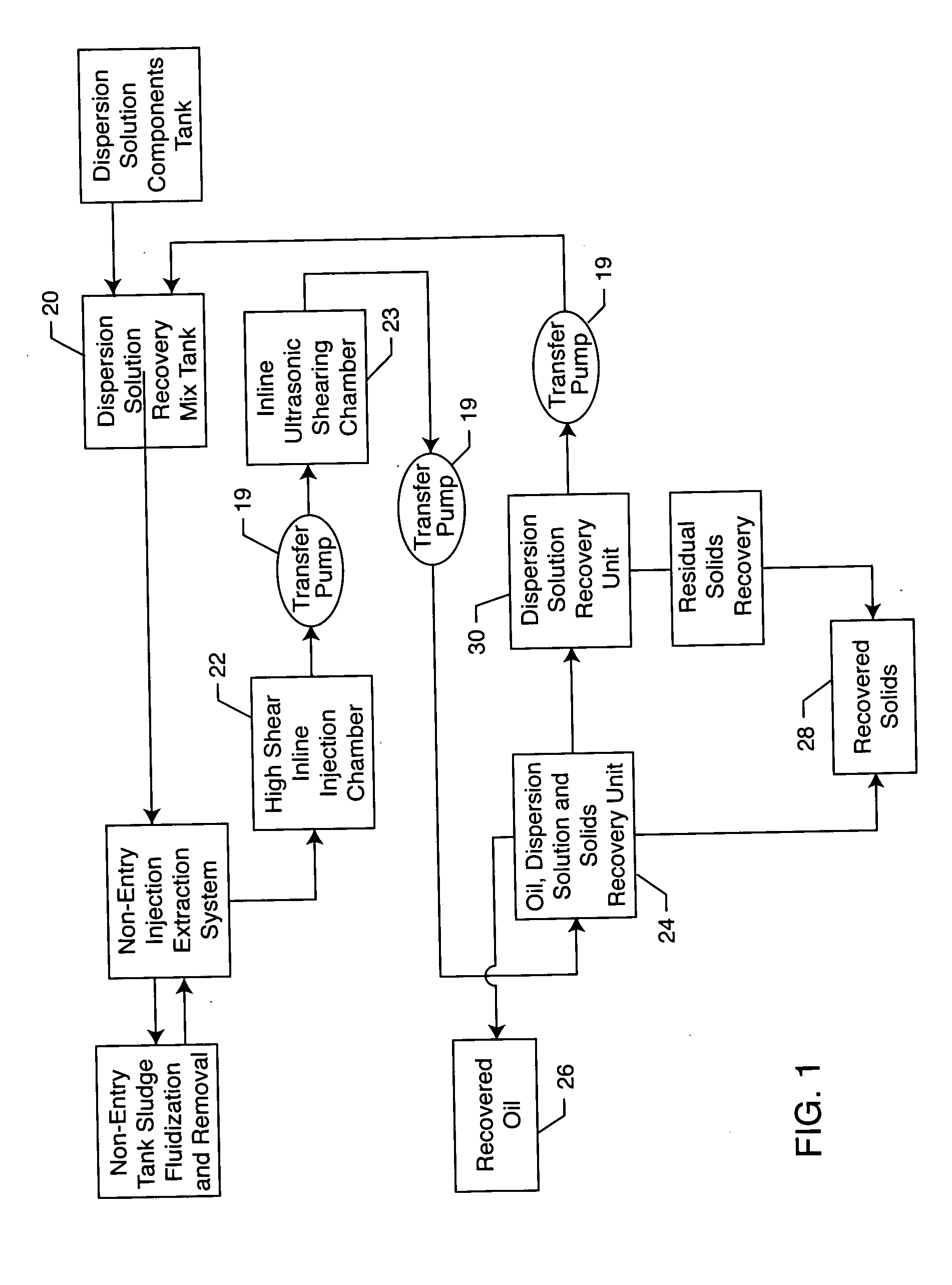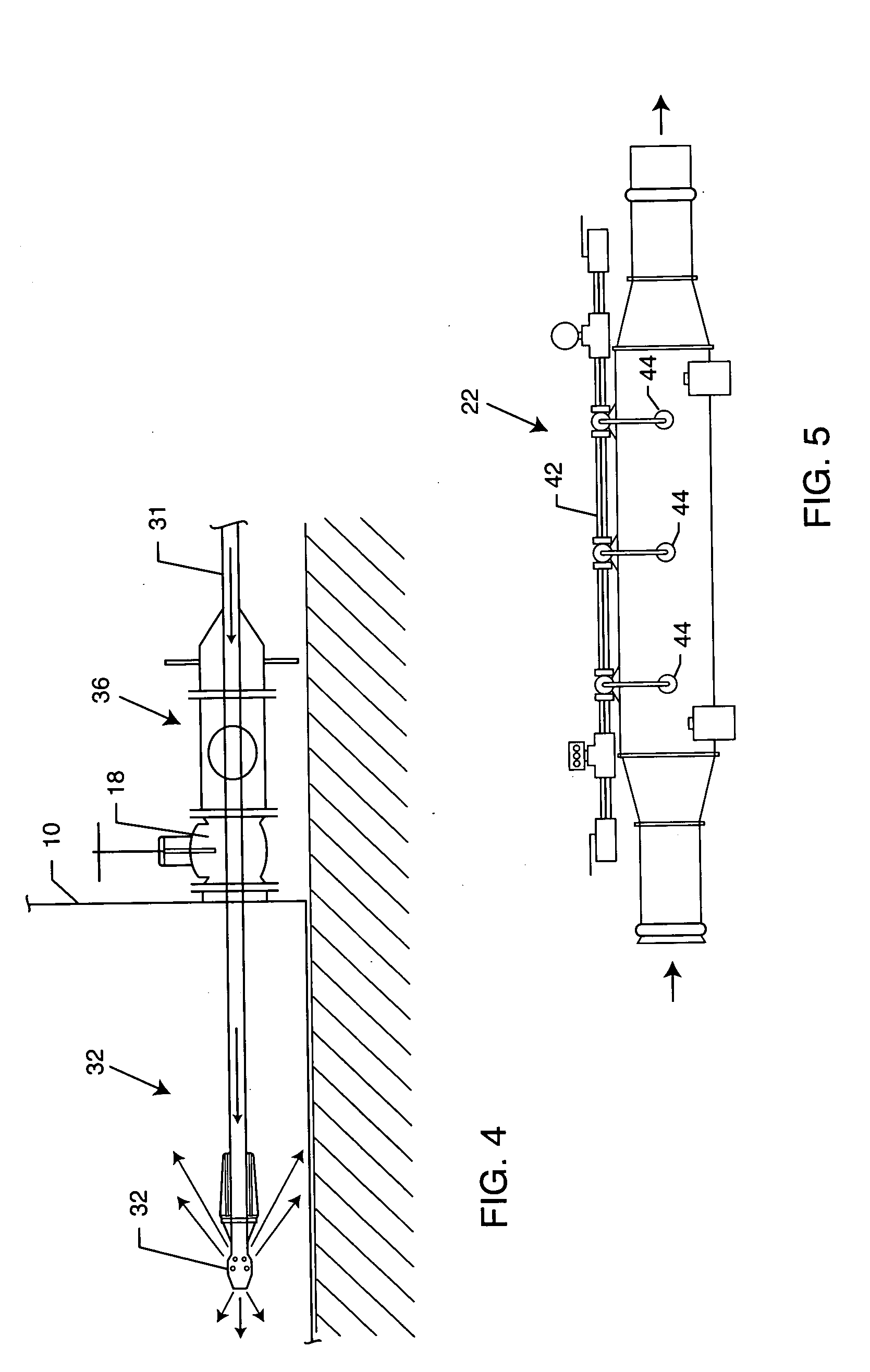Petroleum recovery and cleaning system and process
a technology for cleaning systems and petroleum hydrocarbons, applied in the field of petroleum hydrocarbon production, recovery and handling, can solve the problems of significant environmental and worker safety hazards, abandonment of operational wellheads, and a number of important problems and limitations in the petroleum industry, so as to achieve effective system and method, enhance petroleum recovery and production, and prevent or minimize subsequent sludge accumulation.
- Summary
- Abstract
- Description
- Claims
- Application Information
AI Technical Summary
Benefits of technology
Problems solved by technology
Method used
Image
Examples
example 1
[0046] The system and process of the present invention are useful in fluidizing petroleum-based sludge accumulated at the bottom of a settling or storage tank of the type commonly used in a refinery facility, to permit solid contaminants and the like to fall out of suspension and accumulate at the tank bottom as a sediment in the form of a heavy, petroleum-based and almost solid waste product. Following an appropriate settling interval, the resultant clarified and more viscous oil product within an upper region of the settling tank is skimmed off for appropriate refining processes.
[0047] The objective of the present invention is to economically remove and dispose of this petroleum-based sludge, which may comprise on the order of about 3,500 barrels (bbls.) of accumulated material at the bottom of a typical refinery storage / settling tank having an overall petroleum storage capacity on the order of about 100,000 bbls., in a manner consistent with minimal disruption of refinery operat...
example 2
[0051] In an alternative exemplary test of the invention, accumulated petroleum-based sludge is again removed from the bottom of a refinery storage settling tank, similar to the test described in Example 1 above, but without direct worker access to the tank interior. Accordingly, in this Example 2, workers were not subjected to the potentially toxic atmosphere within the tank interior. The storage / settling tank had a diametric size of about 90 feet, and included about 5,700 bbls. of accumulated petroleum-based sludge in sludge dunes ranging from about 4 to 6 feet in height. In this particular test, the accumulated crude oil sludge included a significant volume of suspended sand particulate and some proprietary catalyst, resulting in heavy oil deposits that would be very difficult to remove.
[0052] In this test, the dispersion fluid (prepared as described in Example 1, with a sodium metasilicate concentration of about 0.1%) was injected into the tank interior at a flow rate of about ...
example 3
[0055] In some instances, there is minimal commercial interest or opportunity in processing fluidized petroleum-based sludge material recovered as described, i.e., in Examples 1 and 2 above. In that event, economic and preferably environmentally compatible disposal represents another preferred option. Accordingly, as one application of the present invention, fluidized sludge material can be disposed by pumping such material down-hole into an exhausted or otherwise abandoned oil well, as opposed to traditional yet costly landfill disposal.
[0056] In this example of the invention, petroleum-based sludge material including very viscous asphaltene rich sludge, sand and clay was fluidized in the manner and using the dispersion fluid as described above in Example 1. Such sludge material was successfully removed from refinery storage tanks into vacuum trucks, transported to an abandoned well site, and then pumped or injected down-hole for disposal. Volatile hydrocarbon material was substan...
PUM
| Property | Measurement | Unit |
|---|---|---|
| Pressure | aaaaa | aaaaa |
| Pressure | aaaaa | aaaaa |
| Percent by volume | aaaaa | aaaaa |
Abstract
Description
Claims
Application Information
 Login to View More
Login to View More - R&D
- Intellectual Property
- Life Sciences
- Materials
- Tech Scout
- Unparalleled Data Quality
- Higher Quality Content
- 60% Fewer Hallucinations
Browse by: Latest US Patents, China's latest patents, Technical Efficacy Thesaurus, Application Domain, Technology Topic, Popular Technical Reports.
© 2025 PatSnap. All rights reserved.Legal|Privacy policy|Modern Slavery Act Transparency Statement|Sitemap|About US| Contact US: help@patsnap.com



